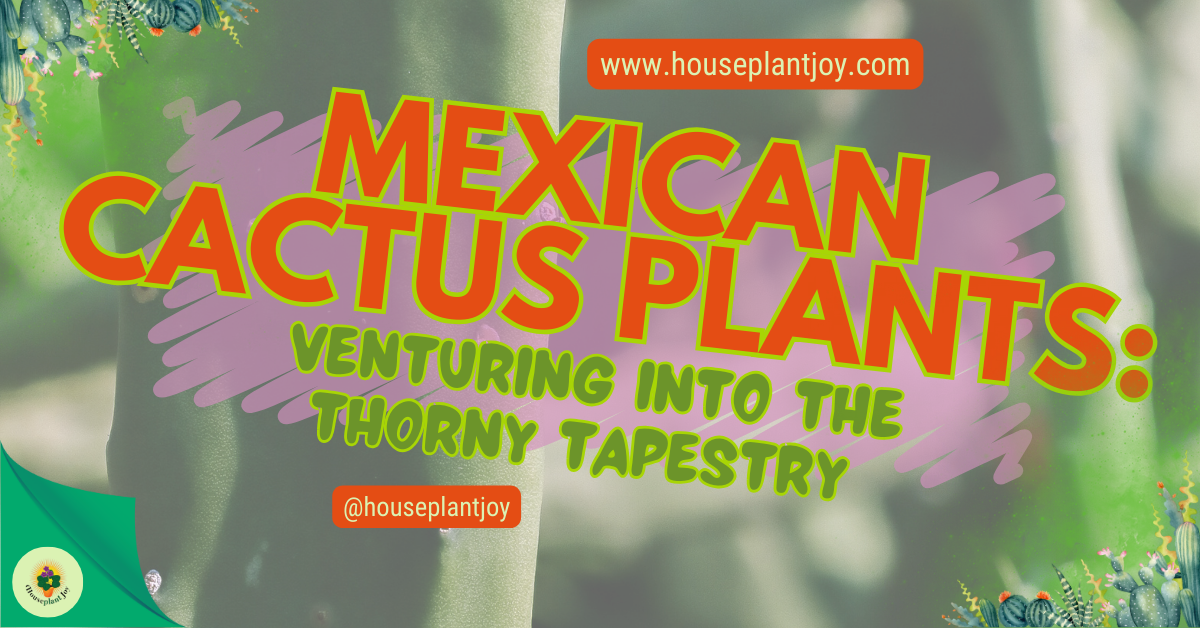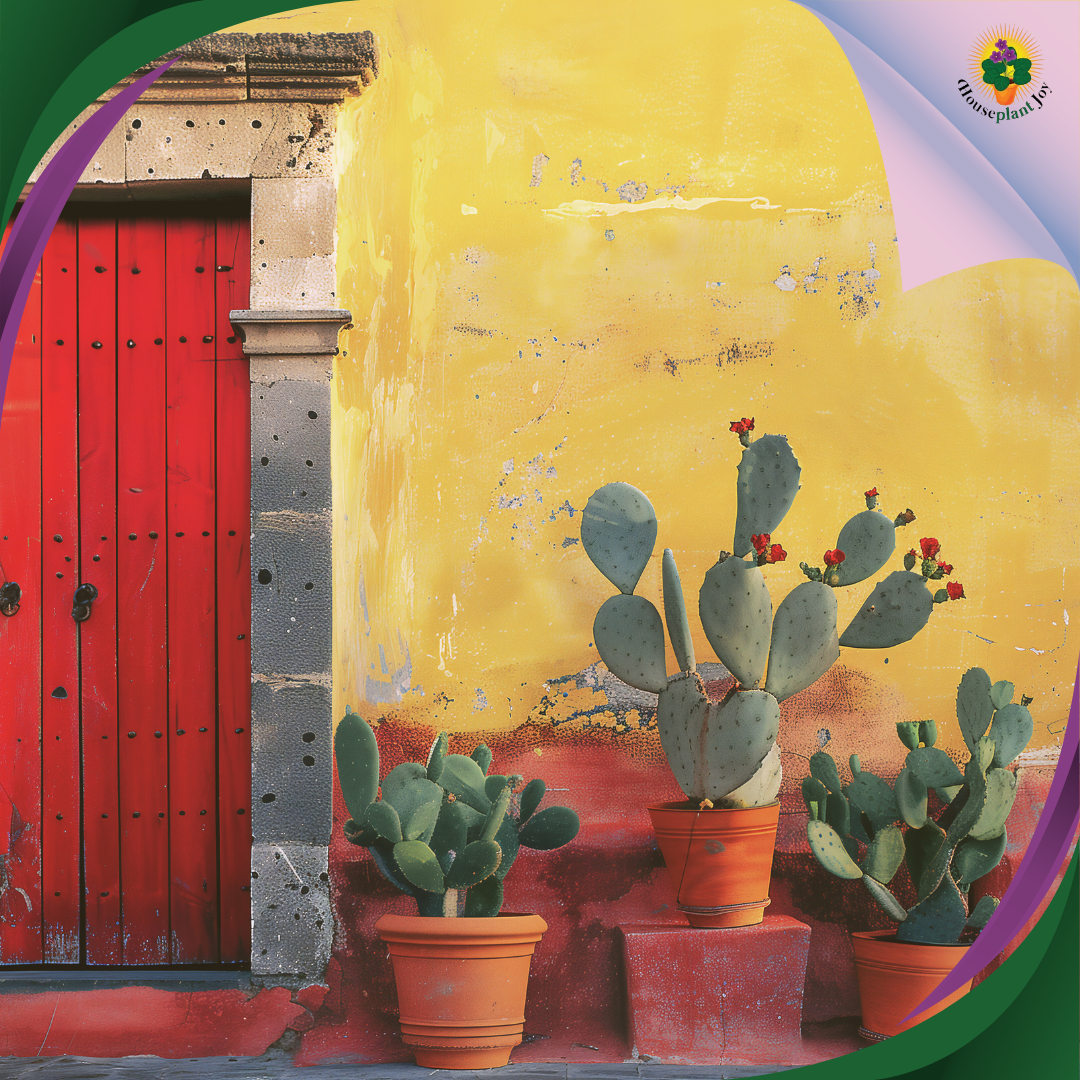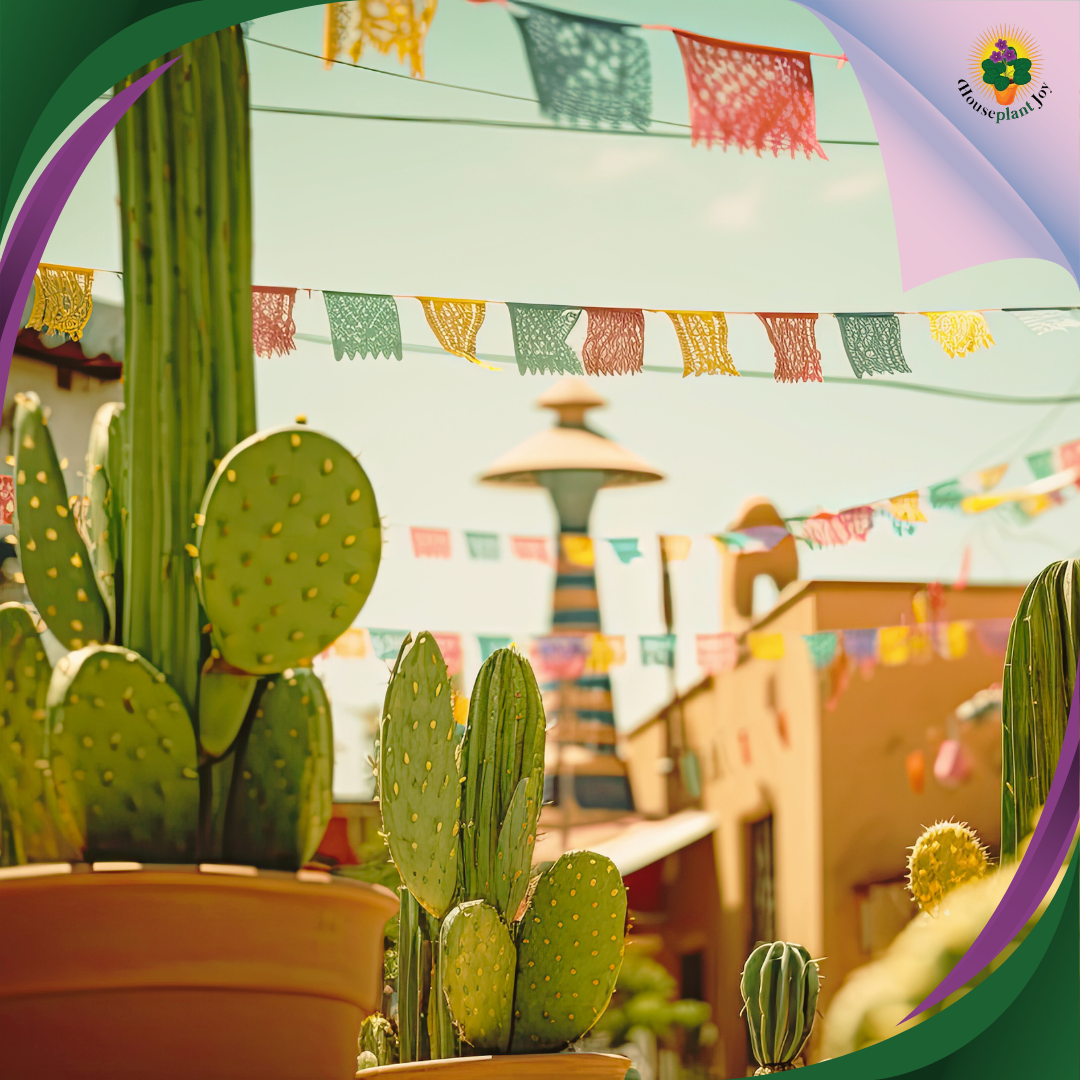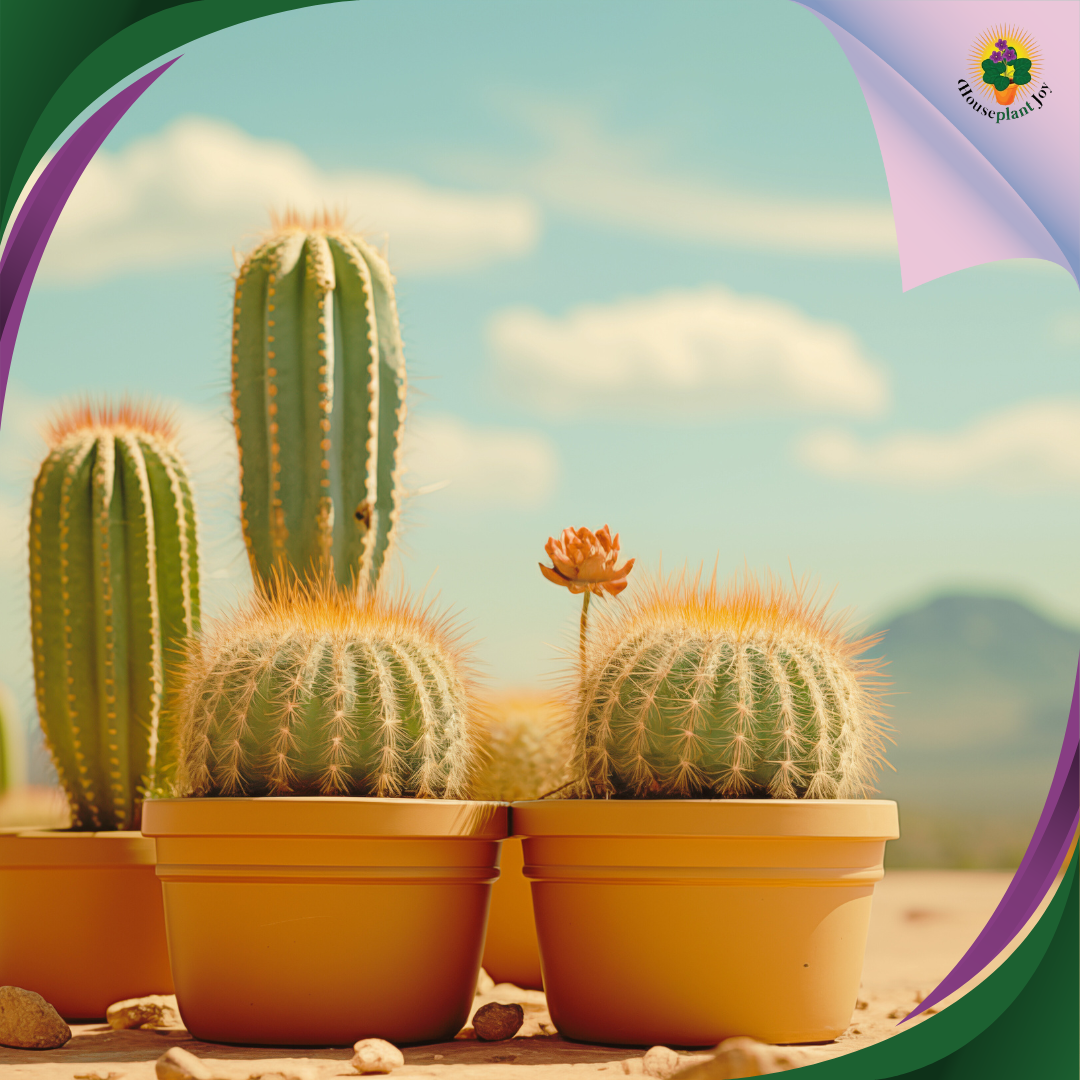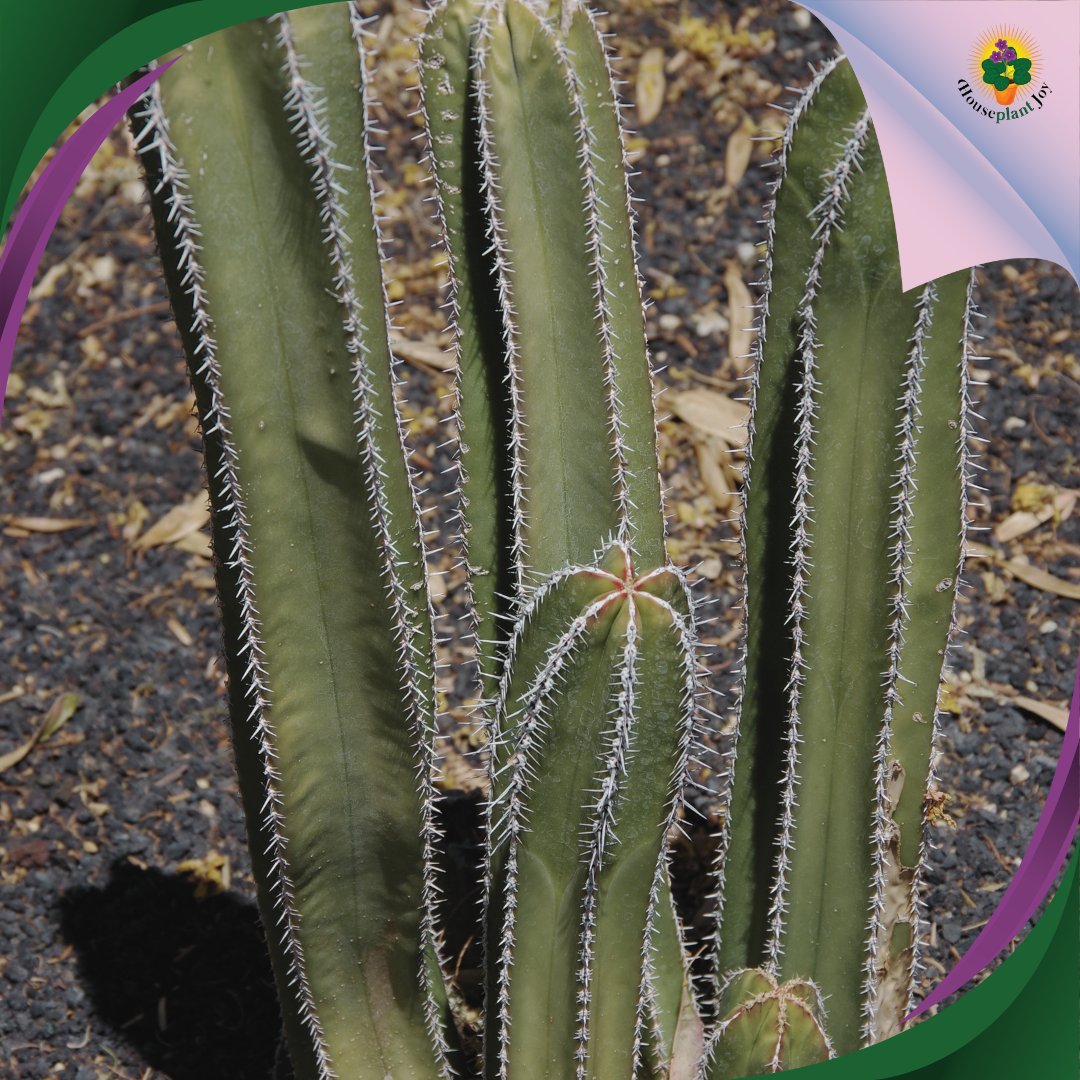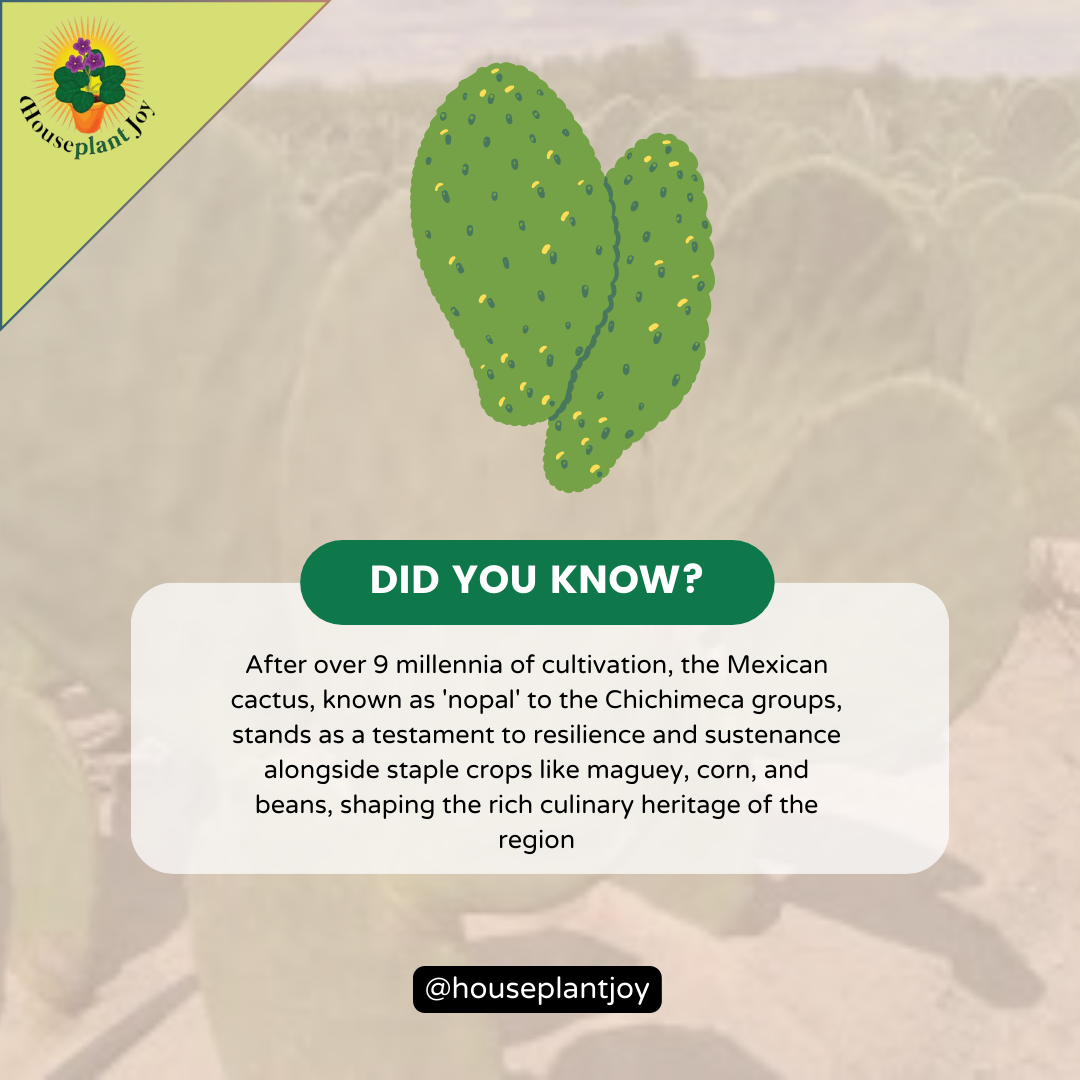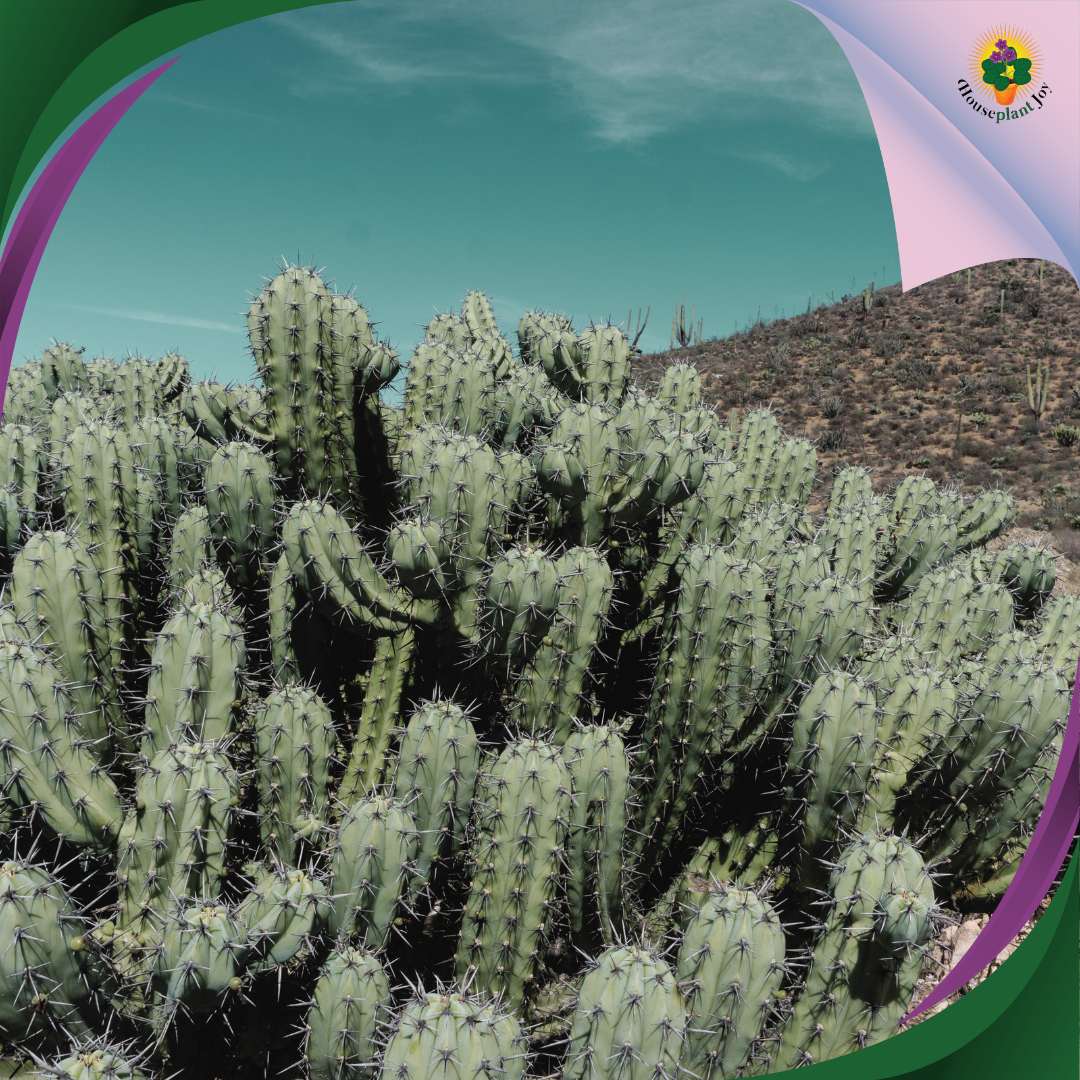HousePlantJoy is supported by our audience. When you purchase through one of our links, we may earn a small affiliate commission. As an Amazon Associate I earn from qualifying purchases. Your cost is not affected.
==================
Mexican Cactus Plants weave tales of resilience through their myriad shapes and vibrant spirits. It’s why I find it most interesting, to be honest.
Let me tell you about my recent fascination with Mexican cacti – those tough, spiky beauties that have found a special place in my heart (and my home!). As I’ve watched my own cactus thrive despite my occasional neglect, I couldn’t help but wonder about the incredible world of cacti out there, especially those native to Mexico. They’re not just plants; they’re resilient survivors, cultural icons, and culinary delights all rolled into one. Join me as I share some insights and discoveries about these fascinating Mexican cacti that have captured my imagination. It’s time to dive into the prickly, yet incredibly captivating, world of Mexican cactus plants!
Mexican Cactus Plants: Delving into the Enigmatic Realm
I have this amazing cactus at home, and it made me curious about all the other types of cacti out there, especially the ones from Mexico. They’re so unique and tough, surviving in places where not much else can. But not many people know much about them, and they face many challenges, like changing climates and people taking over their habitats.
So, I wanted to share this cool world of Mexican cacti with you. Let’s learn about their beauty and how we can help protect them.
Main Scoop
- Mexican cactus is not only an important cultural and historical symbol in Mexico but also a staple in Mexican cuisine.
- The Mexican flag features a cactus, representing the founding of Mexico City.
- Mexican cactus offers various health benefits, including being rich in water, fiber, calcium, and potassium.
- The most common variety of edible cactus in Mexico is Nopales, which is used in various dishes.
- Mexican cactus was domesticated over 9,000 years ago and has been a main food source for many indigenous groups.
- Mexican cactus is versatile and can be cooked in various ways, such as grilling, roasting, or stewing.
- The colorful flowers and fruit of the cactus are known as Prickly Pear, which is a delicious fruit with crunchy seeds.
- Mexican cactus plays a significant role in Mexican culture and traditions.
- Cactus is an important ingredient in Mexican cuisine, from street food to fine dining.
- Mexican cactus is also used in natural medicine and weight-loss diets due to its health benefits.
Nurturing Your Mexican Cacti: A Beginner’s Guide to Care and Maintenance
Mexican cacti, known for their diverse presence in the unique ecosystems of Mexico, stand as a testament to the resilience and beauty of nature in arid conditions. The prickly pear cactus (Opuntia) is among the most recognizable, thriving in sandy soil and embodying the spirit of the desert southwest. These cacti are not just plants; they are a cultural emblem, deeply woven into the fabric of Mexican heritage and cuisine. From adding a distinct flavor and texture to various dishes in Mexican culinary traditions to being celebrated in legends, the cactus holds a place of honor in Mexico’s heart.
In this blog, we will delve into the world of Mexican cacti, exploring their unique ecosystems, cultural significance, and the various types that thrive in different regions of Mexico. We will also uncover the anatomy of a cactus, its adaptations to the desert environment, and the photosynthesis process that allows cacti to thrive in arid conditions.
Whether you’re a cactus enthusiast, a food lover, or simply curious about Mexican culture, this comprehensive guide will provide you with a deeper understanding of the fascinating world of Mexican cacti and their importance in Mexico and beyond.
The Unique Ecosystems They Inhabit
Mexican cacti are well-adapted to the desert southwest of Mexico, where they thrive in sandy soil and arid conditions. The desert southwest provides the perfect habitat for these resilient plants to grow and reproduce. One of the most common Mexican cacti found in this region is the prickly pear cactus (Opuntia), known for its distinctive flat pads and vibrant flowers.
In addition to the desert southwest, Mexican cacti can also be found in other regions with similar climates, such as the Caribbean islands and parts of North and Latin America. These cacti have evolved unique adaptations to survive in these harsh environments, such as thorny spines to deter predators and mechanisms for water retention in sandy soil.
The ability of Mexican cacti to thrive in these ecosystems showcases their resilience and importance in maintaining the delicate balance of desert ecosystems.
The Importance of Cacti in Mexican Culture
Cacti hold great cultural significance in Mexican culture, playing an important role in various aspects of daily life. One of the most iconic representations of cacti in Mexican culture is the Aztec legend of the founding of Mexico City.
According to the legend, the Aztecs were instructed by the gods to build their city where they saw an eagle perched on a cactus, devouring a serpent. This legend is commemorated on the Mexican flag, with the eagle, serpent, and cactus symbolizing the triumph of good over evil.
In addition to the legend, cacti have a strong presence in Mexican cuisine. From street food to fine dining, cacti are widely used in traditional Mexican dishes, adding a unique flavor and texture. Nopales, the most common variety of edible cactus in Mexico, are often used in salads, tacos, and other dishes. The cultural significance of cacti in Mexican cuisine reflects the deep connection between food and culture in Mexico.
The Anatomy of Mexican Cactus Plants
To understand Mexican cacti better, it is essential to explore their anatomy and the unique adaptations they possess. One common Mexican cactus is the prickly pear, known for its fleshy pads and thorny spines. The nopal cactus, another popular variety, also has distinct characteristics and adaptations that allow it to survive in arid environments.
These adaptations include thorns for protection against predators, mechanisms for water retention, and specialized root systems to anchor themselves in sandy soil. Understanding the anatomy and adaptations of Mexican cacti helps shed light on their resilience and ability to thrive in challenging conditions.
Adaptations to the Desert Environment
Mexican cacti have evolved various adaptations to survive in the harsh desert environment. One of the most notable adaptations is the presence of thorns or spines, which serve as a defense mechanism against herbivores. These spines not only deter animals from feeding on the cacti but also provide shade and reduce water loss by creating a microclimate around the plant.
Another crucial adaptation of Mexican cacti is their ability to retain water. The fleshy pads of cacti act as water storage organs, allowing the plants to survive long periods of drought. Additionally, cacti have specialized root systems that help them absorb water efficiently from sandy soil, which has low water-holding capacity.
These adaptations enable Mexican cacti to thrive in arid environments, making them a vital part of the desert ecosystem. By conserving water and withstanding extreme temperatures, cacti provide stability to the ecosystem and support the survival of other organisms in these challenging habitats.
Photosynthesis Process in Cacti
Like other plants, Mexican cacti undergo photosynthesis to produce energy for growth and survival. The prickly pear cactus, a common Mexican cactus, carries out photosynthesis uniquely. Due to the scarcity of water in their environment, cacti have evolved a specialized form of photosynthesis called Crassulacean Acid Metabolism (CAM).
This process allows them to open their stomata, or tiny pores on their surface, at night when the temperature is cooler and water loss is minimized. During this time, the cacti take in carbon dioxide and store it as malic acid in their cells. This stored acid is then converted back to carbon dioxide during the day, when the stomata are closed, and photosynthesis takes place.
Opuntia species, a genus of cacti that includes the prickly pear, are known for their efficient CAM photosynthesis, allowing them to survive in arid conditions where water availability is limited. This unique adaptation enables Mexican cacti to thrive in their natural habitats and contribute to the ecosystem’s overall productivity.
Types of Mexican Cacti
Mexican cacti encompass a wide range of species, each with its own unique characteristics and adaptations. One common group of Mexican cacti is the Opuntia cacti, which includes the prickly pear and other species. These many cacti are recognized for their flat pads, vibrant flowers, and edible fruits.
Beyond Opuntia, there are numerous other cacti species found throughout Mexico, each with its own distinct features and common names. Exploring the different types of Mexican cacti provides a deeper understanding of the diversity and beauty of these plants.
Common Varieties and Their Characteristics
Mexican cacti are known for their diverse range of varieties, each with its own set of characteristics. Let’s take a closer look at some common varieties of Mexican cacti:
- Agave Cactus: Often mistaken for a cactus, the agave is a succulent that shares similar arid habitat preferences. It is a vital ingredient in traditional Mexican spirits like tequila and mezcal.
- Hedgehog Cactus: Known for its small, round shape and vibrant pink flowers, this cactus is a colorful addition to the Mexican flora.
- Large Columnar Cactus: Including species such as the Saguaro (Carnegiea gigantea) and the Cardón (Pachycereus pringlei), these towering plants are iconic symbols of the Mexican desert, showcasing impressive blooms of white or yellow flowers.
- Columnar Cacti: This group encompasses a variety of tall, slender cacti, including the popular “pencil cactus” (Euphorbia tirucalli), which is not a true cactus but a succulent with a similar appearance.
- Elephant Cactus (Pachycereus pringlei): Another large cactus species, it stands out for its massive size and is an essential part of the desert landscape.
- Cactus Features: From the spiny defense mechanisms to their stunning flowers in shades of yellow and pink, each cactus species brings unique characteristics that contribute to their survival and beauty.
- Nopal cactus (Opuntia ficus-indica): Characterized by its fleshy pads known as “nopales,” commonly used in Mexican cuisine for their mild flavor and tender texture. They are high in nutritional value, providing fiber, vitamins, and minerals.
- Prickly pear (Opuntia spp.): Recognizable for its flat, oval-shaped pads and vibrant flowers in red, purple, and yellow. The “tuna” fruit offers a sweet and tangy flavor, contributing to its popularity in food.
- Other common varieties: Includes a wide range of species such as the organ pipe cactus (Stenocereus thurberi), barrel cactus (Ferocactus spp.), and cholla cactus (Cylindropuntia spp.), each with unique characteristics and adaptations for thriving in diverse environments.
These common Mexican cacti varieties showcase the diversity and versatility of these plants, both in terms of their culinary uses and their ecological importance.
Rare and Endangered Species
While Mexican cacti are incredibly diverse and abundant, some species are rare and endangered due to habitat loss and other factors. Conservation efforts are crucial to protect these endangered species and preserve the biodiversity of Mexican cacti. Here are some examples of rare and endangered Mexican cacti species:
- Mammillaria hernandezii (Hernandez’s Pincushion Cactus) – Critically Endangered
- Ariocarpus agavoides (Living Rock Cactus) – Vulnerable
- Echinocactus grusonii (Golden Barrel Cactus) – Endangered
These are just a few examples of rare and endangered Mexican cacti species. Habitat loss, illegal collection, and climate change pose significant threats to the survival of these plants. Conservation efforts, such as protected areas and legal restrictions on harvesting wild cacti, are essential to ensure the long-term survival of these unique and valuable species.
Geographical Distribution
Mexican cacti have a wide geographical distribution, with Mexico being their primary habitat. They can be found in various regions of Mexico, including the desert southwest, Mexico City, and other parts of North and Latin America. Outside of Mexico, Mexican cacti can be found in countries such as the United States, Brazil, Cuba, and other Caribbean islands. The diverse climates and landscapes of these regions provide ideal conditions for the growth and survival of Mexican cacti.
Where Mexican Cacti Thrive
Mexican cacti thrive in diverse environments, ranging from arid deserts to tropical regions. In Mexico, the desert southwest is a prime habitat for these resilient plants. The dry, sandy soil and extreme temperatures create ideal conditions for Mexican cacti to grow and reproduce. Additionally, the Caribbean islands are home to various species of Mexican cacti, where they adapt to the tropical climate and thrive in sandy coastal areas.
One notable location for Mexican cacti is Lake Texcoco, located near Mexico City. The lake’s shallow waters and marshy surroundings provide a unique habitat for cacti, where they can withstand fluctuating water levels and nutrient-rich soil. These diverse environments showcase the adaptability and resilience of Mexican cacti, allowing them to thrive in different ecological niches.
Conservation Areas and Efforts
Conservation efforts play a vital role in protecting Mexican cacti and their diverse habitats. Various organizations and government agencies are actively working towards preserving these plants and their ecological importance.
One key aspect of conservation is the establishment of protected areas, where Mexican cacti can grow and reproduce undisturbed. These protected areas provide a safe haven for endangered species and serve as educational resources for the public.
Legal restrictions on the harvesting of wild cacti are also essential for their conservation. These restrictions aim to prevent overexploitation and ensure the sustainable use of Mexican cacti. By implementing regulations and raising awareness about the importance of preserving these plants, conservation efforts can help safeguard the future of Mexican cacti and the ecosystems they inhabit.
The Role of Cacti in the Ecosystem
Mexican cacti play a crucial role in the ecosystem, providing various ecosystem services and supporting the survival of other organisms. They serve as a food source for a wide range of animals, from insects to mammals, offering nourishment and habitat. Additionally, cacti play a vital role in pollination, attracting bees and other pollinators with their colorful flowers. This mutualistic relationship ensures the reproduction and survival of both cacti and pollinators, contributing to the overall biodiversity of the ecosystem.
Cacti as a Source of Food and Water for Wildlife
Mexican cacti are an essential source of food and water for wildlife, including both domesticated livestock and native wildlife species. The fleshy pads and fruits of cacti provide nourishment for various animals, especially during periods of drought when other food sources may be scarce. In desert ecosystems, where water is limited, cacti serve as a reliable water source, storing water in their tissues and providing hydration for wildlife.
This is particularly important for animals that are adapted to arid environments and have specialized physiological mechanisms to conserve water. Mexican cacti are a valuable resource for both livestock and wildlife, ensuring their survival in challenging desert landscapes.
Pollination and the Role of Bees
Pollination is a crucial process for the reproduction of Mexican cacti, and bees play a vital role in this process. As cacti bloom, their flowers attract bees with their bright colors and sweet nectar. Bees visit the flowers in search of food and inadvertently transfer pollen from one flower to another, allowing for fertilization and the production of seeds. This mutualistic relationship between cacti and bees ensures the continuation of both species.
In return for providing pollination services, bees receive a rich source of nectar, which serves as their primary food source. The relationship between Mexican cacti and bees highlights the interconnectedness of species within ecosystems and the importance of biodiversity in maintaining ecosystem health.
Cultural Significance Of Mexican Cactus Plants
Cacti hold immense cultural significance in Mexican culture, representing resilience, adaptability, and strength. They have been used for centuries in various aspects of Mexican life, from traditional medicine to art and folklore.
The Aztecs, in particular, held cacti in high regard and incorporated them into their religious ceremonies and everyday life. Understanding the historical uses and cultural significance of cacti provides a deeper appreciation for their role in Mexican culture and the values they embody.
Historical Uses of Cacti in Mexico
Cacti have been utilized for various purposes throughout Mexico’s history, dating back to the time of the Aztecs. The Aztecs believed that the gods instructed them to build their city, Tenochtitlan, where they saw an eagle perched on a cactus devouring a serpent. This legend is deeply ingrained in Mexican culture and symbolizes the founding of Mexico City.
In addition to their symbolic significance, cacti were used by the Aztecs for practical purposes. The pads and fruits of cacti were consumed as a source of food and water, while the spines were used for medicinal purposes and as tools. Cacti were also incorporated into religious ceremonies and artistic expressions, further highlighting their importance in Aztec society.
The historical uses of cacti in Mexico reflect the resourcefulness and ingenuity of indigenous cultures, who recognized the value of these plants in their everyday lives.
Cacti in Modern Mexican Society
Cacti continue to play a significant role in modern Mexican society, serving as a cultural icon and representing the resilience and adaptability of the Mexican people. In addition to their cultural significance, cacti have found their way into modern uses, ranging from culinary creations to artistic expressions.
Nopales, in particular, have become a popular ingredient in Mexican cuisine, adding a unique flavor and texture to dishes. Cacti are also often featured in Mexican art, literature, and architecture, showcasing their enduring importance in Mexican culture.
Furthermore, cacti have become a symbol of sustainability and environmental consciousness in Mexico. Their ability to thrive in challenging desert environments serves as a reminder of the importance of preserving natural resources and adapting to changing circumstances.
Mexican cacti continue to inspire and captivate people around the world, both for their cultural significance and their unique ecological adaptations.
Culinary Uses of Cacti
Cacti have long been an integral part of Mexican cuisine, adding a distinct flavor and texture to various dishes. Nopales, the fleshy pads of the cactus, are commonly used in traditional Mexican dishes, such as tacos, salads, and stews. The slightly tangy flavor and crisp texture of nopales make them a versatile ingredient in Mexican cooking.
Additionally, cacti are also used to make nopal juice, a refreshing and nutritious beverage that is enjoyed in Mexico and beyond. The culinary uses of cacti showcase their versatility and the rich culinary traditions of Mexican cuisine.
Traditional Dishes Featuring Cacti
Mexican cuisine features a variety of traditional dishes that incorporate cacti, highlighting their unique flavor and texture. Here are some popular dishes that prominently feature cacti:
- Huevos con Nopales: This traditional Mexican breakfast dish combines scrambled eggs with sautéed nopales, onions, and tomatoes. The combination of flavors creates a delicious and satisfying meal.
- Nopal Salad: Nopales can be used in fresh salads, adding a crisp and slightly tangy element. Nopal salads often feature a combination of tomatoes, onions, and avocados, dressed with lime juice and olive oil.
- Cactus Tacos: Nopales can be sautéed and used as a filling for tacos, providing a unique and flavorful vegetarian option.
- Cactus Stir-fry: Nopales can also be stir-fried with other vegetables, such as bell peppers and onions, to create a delicious and nutritious side dish.
These traditional dishes highlight the culinary versatility of cacti and their integration into the vibrant flavors of Mexican cuisine.
Nutritional Benefits of Cacti
In addition to their unique flavor and texture, cacti offer various nutritional benefits. Nopales, in particular, are rich in dietary fiber, vitamins, and minerals, making them a healthy addition to any diet. Here are some of the nutritional benefits of cacti:
- High fiber content: Nopales are particularly high in dietary fiber, which aids in digestion, promotes satiety, and helps regulate blood sugar levels.
- Vitamins and minerals: Cacti are a good source of vitamins A, C, and K, as well as minerals like calcium, potassium, and magnesium.
- Low in calories: Nopales are relatively low in calories, making them a nutritious and satisfying option for weight management.
- Antioxidant properties: Cacti contain antioxidants that help protect the body against oxidative stress and reduce the risk of chronic diseases.
Incorporating cacti into your diet can provide a range of health benefits, contributing to a well-rounded and nutritious eating plan.
Medicinal Uses
Cacti have a long history of use in traditional medicine, with various parts of the plant being employed for their health benefits. From wound healing to digestive health, cacti have been utilized by indigenous cultures for centuries.
In recent years, contemporary research has shed light on the potential health benefits of cacti, leading to increased interest in their medicinal properties. The unique chemical composition of cacti, including their high water content, fiber, and antioxidants, contributes to their potential therapeutic properties. While further research is needed to fully understand the extent of their medicinal uses, cacti continue to be valued for their potential health benefits.
Traditional Remedies Using Cacti
Cacti have been used in traditional medicine for various ailments and health conditions. Indigenous cultures have employed different parts of the cactus for their healing properties. Here are some traditional remedies using cacti:
- Nopal Juice: Nopal juice, made from the prickly pear cactus, is believed to have various health benefits. It is often consumed as a digestive aid and is known for its potential to lower blood sugar levels and cholesterol.
- Wound Healing: Cactus gel, derived from the inner flesh of the plant, has been used topically to promote wound healing and relieve skin irritations.
- Anti-inflammatory Properties: Some cacti, such as the organ pipe cactus, have been traditionally used for their anti-inflammatory properties to alleviate joint pain and inflammation.
These traditional remedies highlight the versatile and healing properties of cacti. While scientific studies are ongoing to validate these claims, cacti continue to be valued in traditional medicine for their potential health benefits.
Contemporary Research on Cacti’s Health Benefits
Contemporary research has shown promising results regarding the potential health benefits of cacti. Scientific studies have shed light on the unique properties of cacti, revealing their potential medicinal properties. Here are some areas of ongoing research on cacti’s health benefits:
- Anti-inflammatory effects: Some studies suggest that cacti may have anti-inflammatory properties, which could be beneficial in the treatment of conditions such as arthritis and inflammation-related diseases.
- Antioxidant activity: Cacti are rich in antioxidants, which help protect the body against oxidative stress and reduce the risk of chronic diseases.
- Blood sugar regulation: Research has shown that certain compounds found in cacti, such as soluble dietary fiber and polyphenols, may help regulate blood sugar levels and improve insulin sensitivity.
While more research is needed to fully understand and validate these findings, contemporary studies provide promising insights into the potential health benefits of cacti. Continued research on cacti’s medicinal properties could lead to new therapeutic applications in the future.
Celebrating Mexican Cactus Plants: Resilience and Beauty
In the end of our discussion on the Mexican cactus plants, we reflect on their resilient nature, cultural significance, and the myriad benefits they bring. From their iconic presence on the Mexican flag to their versatile culinary uses and potential health benefits, these plants have woven tales of survival and vitality that inspire awe.
Through their adaptability to harsh environments and their integral role in supporting wildlife and human communities, Mexican cacti have exemplified the intricate balance of nature. As we delved into their rich history and explored their diverse species, we uncovered a deeper appreciation for these remarkable plants.
We invite you to celebrate the beauty and significance of Mexican cactus plants by incorporating them into your home and exploring their fascinating characteristics. For more insights and tips on houseplants, visit our blog at Houseplantjoy. Let’s continue cultivating joy and greenery together, remembering the resilience and beauty of Mexican cacti with every prickly embrace.
Frequently Asked Questions
How to Care for Mexican Cacti at Home?
Caring for Mexican cacti at home requires attention to specific care needs. Here are some guidelines for caring for Mexican cacti:
- Watering: Mexican cacti prefer well-draining soil and should be watered sparingly. Allow the soil to dry out between waterings to prevent root rot.
- Sunlight: Mexican cacti thrive in bright sunlight and should be placed in a sunny location, preferably near a south-facing window.
- Soil: Use a well-draining cactus mix or create a soil mixture with sand, perlite, and potting soil to ensure proper drainage.
- Pruning: Mexican cacti may require occasional pruning to remove dead or damaged parts. Use clean, sharp pruning shears and wear protective gloves to avoid injury from spines.
By following these care guidelines, you can ensure the health and longevity of your Mexican cacti at home.
Are There Any Legal Restrictions on Harvesting Wild Cacti in Mexico?
Yes, there are legal restrictions on harvesting wild cacti in Mexico to protect the natural habitats and preserve the biodiversity of these plants. Conservation laws regulate the collection of wild cacti to ensure their sustainable use and prevent overexploitation. It is important to respect these laws and consider the long-term impact of harvesting wild cacti on the ecosystem.

